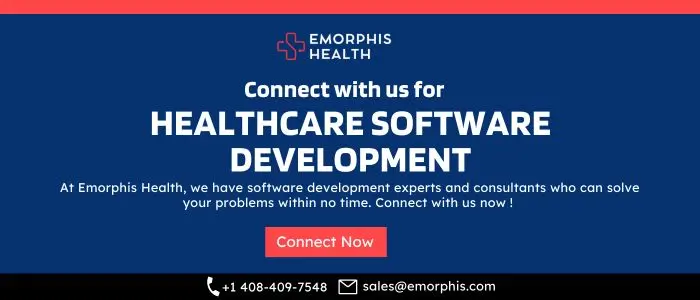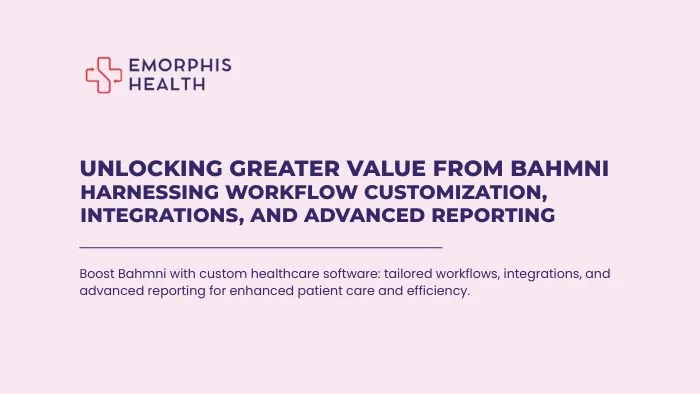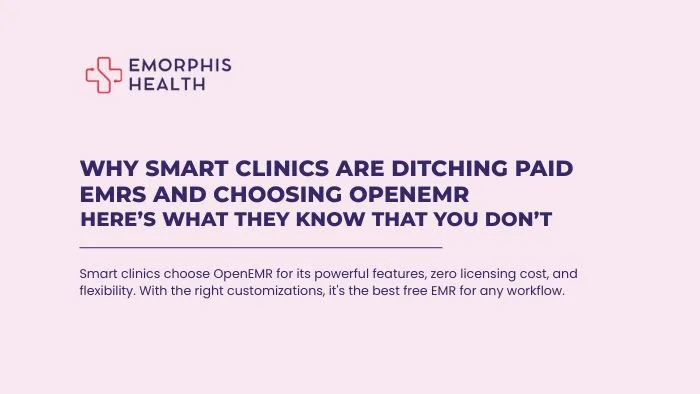In the dynamic healthcare landscape, the incorporation of advanced software is not merely a trend but a transformative force. According to the latest report from MarketsandMarkets™, the Digital Health market, assessed at $180.2 billion in revenue in 2023, is projected to reach an estimated $549.7 billion by 2028, exhibiting a notable CAGR of 25.0% from 2023 to 2028. This underscores the pivotal role of healthcare software development in enhancing patient care, streamlining medical workflows, improving efficiency, and reducing costs, signifying a robust and growing industry poised for substantial advancements in the coming years. Healthcare software development trends will play a vital role in the future of medicine.
Now, let us take a look at the benefits of Healthcare Software.
Revolutionizing Healthcare: Exploring the Benefits of Software Integration
See Contents
- 1 Revolutionizing Healthcare: Exploring the Benefits of Software Integration
- 2 Types of Healthcare Software in 2024
- 3 Custom Healthcare software development in 2024
- 4 Current Trends in Healthcare Software Development
- 5 Future Outlook with Emerging Technologies in Healthcare Software Development
- 6 Conclusion
A. Enhanced Patient Care
Healthcare software, moreover, acts as a catalyst for elevated patient care. Through intuitive interfaces and real-time data access, medical professionals can make informed decisions promptly. This not only improves the overall patient experience but also ensures that treatments are tailored to individual needs.
B. Streamlined Medical Workflows
As a matter of fact, the integration of software leads to streamlined medical workflows. Tasks that were once time-consuming and error-prone are now executed seamlessly. Administrative processes, appointments, and data management are all synchronized, allowing healthcare providers to focus more on patient interaction rather than bureaucratic hurdles.
C. Improved Efficiency and Cost Reduction
In fact, the efficiency gains from healthcare software result in significant cost reductions. Automating routine tasks not only saves time but also minimizes the margin of error. This leads to resource optimization, allowing healthcare organizations to allocate their budget more effectively and channel funds where they matter the most – patient well-being.
D. Increased Accessibility and Convenience
Also, healthcare software increases accessibility and convenience for patients and healthcare professionals. Telemedicine, for instance, enables remote consultations and monitoring. This not only broadens the reach of healthcare services but also provides convenience for patients who may have geographical or mobility constraints.
Moving forward, let’s delve deeper into the transformative landscape of healthcare software by exploring the specific types that are shaping the industry in 2024.
Types of Healthcare Software in 2024
1. Electronic Health Records (EHRs)
In fact, Electronic Health Records (EHRs) are the cornerstone of modern healthcare software. These digital records not only store patient information securely but also ensure its accessibility by authorized personnel. With streamlined data sharing among healthcare providers, EHR systems contribute significantly to the continuity and quality of patient care.
Connect with us for EMR/EHR Development and Integration Services
2. Telemedicine and Remote Patient Monitoring
Moreover, the rise of telemedicine app development solutions and remote patient monitoring has revolutionized healthcare accessibility. In this era, patients can receive medical consultations from the comfort of their homes. Additionally, continuous remote monitoring through wearable devices provides real-time data, allowing healthcare professionals to intervene promptly and personalize treatment plans.
Connect with us for Remote patient monitoring
3. Hospital Management Systems
As a matter of fact, Hospital Management Systems are pivotal in optimizing healthcare facilities’ administrative and operational aspects. These systems efficiently manage appointments, billing, inventory, and other logistical tasks, ensuring a well-coordinated and organized healthcare environment.
4. Clinical Decision Support Systems (CDSS)
Also, Clinical Decision Support Systems (CDSS) play a crucial role in aiding healthcare professionals in making informed decisions. By analyzing patient data and medical literature, CDSS provides evidence-based recommendations, reducing the margin of error and improving the overall quality of care.
Click the link to find out how Healthcare Analytics Software helps in critical decision-making.
5. Wearable and Mobile Health Technology
In fact, the integration of wearable and mobile health technology empowers individuals to actively participate in their healthcare journey. From fitness trackers to mobile apps, these technologies not only promote preventive health measures but also enable individuals to monitor and manage their health conveniently.
Overall, the diverse array of healthcare software types in 2024 reflects a comprehensive approach to addressing the complex needs of the industry. From managing patient records to facilitating remote care and enhancing decision-making, these technologies collectively contribute to a healthcare ecosystem that is not only efficient but also patient-centric. As we embrace these innovations, the healthcare landscape continues to evolve, promising a future where technology seamlessly integrates with compassionate care.
Now, let’s shift our focus to the pivotal process of custom healthcare software development in 2024, a crucial element in tailoring solutions to the specific needs of healthcare providers and organizations.
Custom Healthcare software development in 2024
a. Design and Prototyping
In the realm of custom healthcare software development, the journey commences with meticulous design and prototyping. This phase is pivotal as it involves collaborating closely with healthcare professionals to understand their unique requirements. By creating prototypes, developers ensure that the software aligns seamlessly with the workflow and objectives of the healthcare institution.
b. Development and Coding
Moreover, the actual development and coding phase brings the envisioned software to life. Utilizing the latest technologies, developers work rigorously to translate the design into functional code. This active development process involves continuous communication with stakeholders to address any emerging needs and refine the software accordingly.
c. Testing and Quality Assurance
As a matter of fact, rigorous testing and quality assurance are imperative to ensure that the custom healthcare software meets the highest standards. Through systematic testing protocols, developers identify and rectify any bugs or issues, guaranteeing that the software performs reliably and securely in real-world healthcare scenarios.
d. Deployment and Maintenance
Also, the deployment and maintenance phase marks the culmination of the development process. The seamless integration of the custom software into the healthcare environment is carefully orchestrated, and ongoing maintenance ensures that the software remains up-to-date and adaptive to evolving healthcare needs.
Overall, the bespoke nature of custom healthcare software development in 2024 signifies a commitment to precision and effectiveness. From the initial design and prototyping to the ongoing maintenance, each phase is meticulously executed to ensure that the resulting software not only meets but exceeds the expectations of healthcare professionals, contributing significantly to the industry’s technological advancement and improved patient care.
As we navigate the ever-evolving landscape of healthcare software, let’s explore the current trends that are shaping the industry in 2024, influencing the development and customization of software solutions to meet the dynamic needs of healthcare providers.
Current Trends in Healthcare Software Development
Trend 1. Integration of AI and Machine Learning
In fact, the integration of Artificial Intelligence (AI) and Machine Learning (ML) stands out as a game-changer in healthcare software development. These AI in healthcare technology not only enhance diagnostic accuracy and treatment planning but also contribute to predictive analytics, enabling healthcare professionals to proactively address potential health issues.
Find the use cases of Generative AI in Healthcare
Trend 2. Telehealth and Remote Patient Monitoring
Moreover, the rise of telehealth and remote patient monitoring continues to be a prominent trend. The seamless integration of video consultations and wearable devices facilitates remote healthcare delivery. This not only improves patient access but also allows healthcare providers to monitor patients in real time, fostering a more proactive and personalized approach to care.
Trend 3. Data Interoperability and Exchange
As a matter of fact, data interoperability and exchange have become paramount in healthcare software development. Efforts are directed towards creating standardized data formats, ensuring seamless communication and information exchange between different healthcare systems. This interoperability enhances the efficiency of healthcare processes and promotes a holistic view of patient health.
Trend 4. Cybersecurity in Healthcare Software
Also, cybersecurity in healthcare software is a critical focus area. With the increasing reliance on digital platforms, safeguarding patient data from cyber threats is of utmost importance. Developers are integrating robust security measures, encryption protocols, and regular audits to ensure that healthcare data remains confidential and protected against potential breaches.
Overall, staying abreast of current trends in healthcare software development is essential for crafting solutions that align with the industry’s evolving needs. From the infusion of AI and ML for intelligent insights to ensuring secure data exchange and embracing telehealth innovations, these trends collectively propel the healthcare sector towards a future where technology not only supports but enhances the delivery of quality patient care.
Looking ahead, let’s explore the exciting future outlook and emerging technologies that are poised to redefine the landscape of healthcare software development, anticipating the trends that will shape the industry in the coming years.
Future Outlook with Emerging Technologies in Healthcare Software Development
a. Precision Medicine and Personalized Healthcare
As we peer into the future, precision medicine and personalized healthcare emerge as forefront trends. The integration of genetic data, patient history, and real-time monitoring will pave the way for customized treatment plans tailored to individual genetic makeup and lifestyle factors. This approach not only enhances treatment efficacy but also minimizes adverse effects, marking a paradigm shift towards more targeted and patient-centric healthcare.
b. 5G Technology in Healthcare
Moreover, the advent of 5G technology is set to revolutionize healthcare by providing ultra-fast and reliable connectivity. This not only facilitates seamless communication between healthcare devices but also enables the real-time transfer of large medical datasets. The enhanced connectivity opens doors to remote surgeries, augmented reality consultations, and other high-bandwidth applications, ushering in a new era of connectivity in the healthcare sector.
c. Augmented Reality (AR) and Virtual Reality (VR) in Healthcare
As a matter of fact, Augmented Reality (AR) and Virtual Reality (VR) are poised to play a transformative role in healthcare applications. From immersive surgical training simulations to virtual rehabilitation programs, these technologies offer innovative solutions to enhance medical education, improve patient outcomes, and provide therapeutic interventions. The immersive nature of AR and VR has the potential to revolutionize medical training, patient education, and even surgical procedures.
The future of healthcare software development is teeming with exciting possibilities, from tailoring treatments based on individual genetic profiles to leveraging advanced connectivity and immersive technologies. As we embrace these emerging trends, the healthcare industry is on the brink of a technological renaissance that promises not only improved patient care but also a more interconnected and personalized approach to healthcare delivery.
Conclusion
In conclusion, the reimagining of healthcare through software is shaping a sustainable future for healthcare delivery. From custom development to emerging technologies, the industry is embracing tools that streamline processes and reduce costs, fostering a resilient healthcare infrastructure.
Moreover, healthcare software empowers patients to participate in their well-being actively, optimizing overall outcomes through telehealth, wearables, and personalized treatment plans. This unending journey of innovation, marked by AI integration, augmented reality, and personalized medicine, ensures healthcare remains dynamic and adaptable.
In this transformative landscape, the software serves as a thread weaving together efficiency, accessibility, and quality care, promising not just a technologically advanced healthcare system but one deeply rooted in compassion and the pursuit of better health for all.









